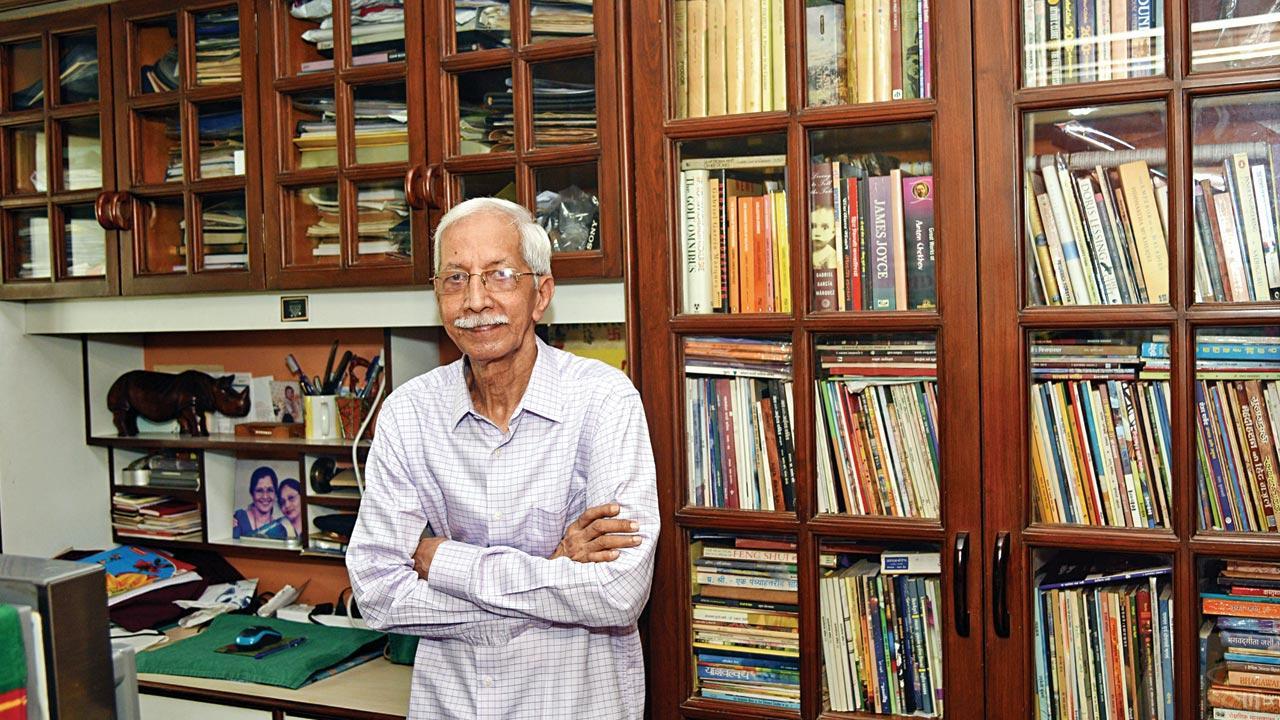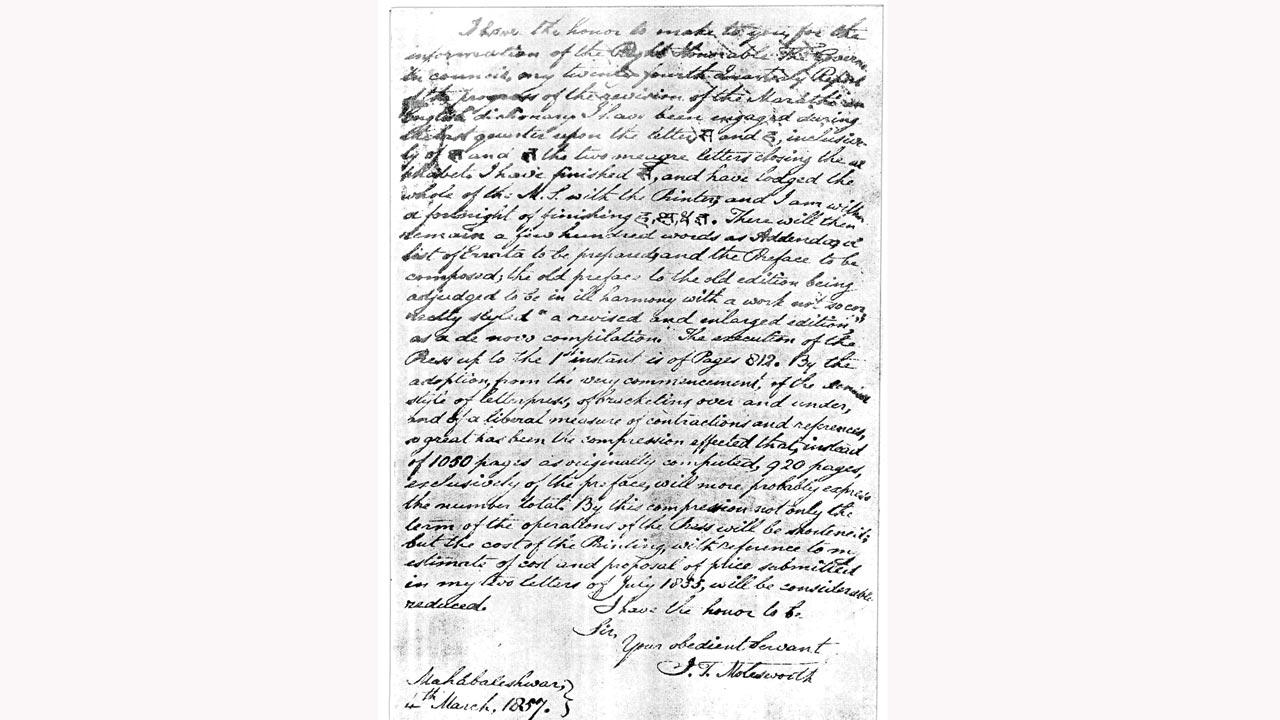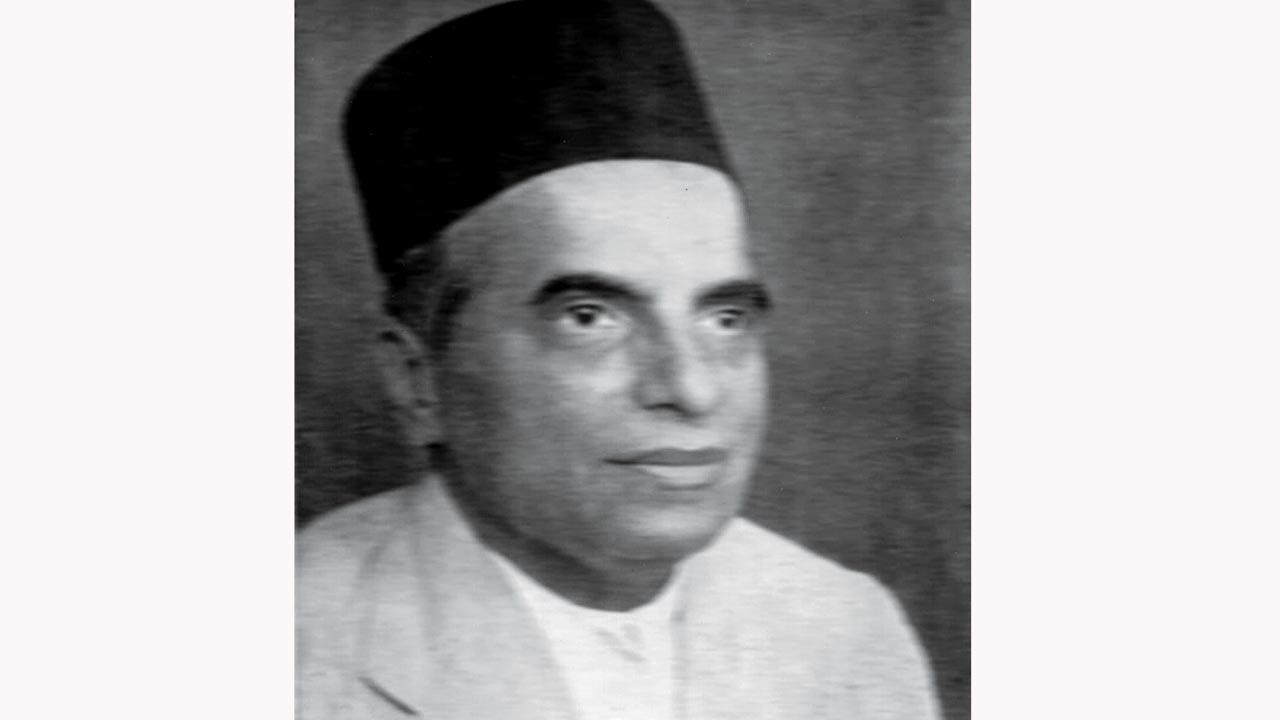A new bilingual book on the first Marathi-English dictionary, written 200 years ago, commemorates a British lexicographer’s love for Indian languages

Translator-editor Arun Nerurkar who has worked on the book on British lexicographer James Thomas Molesworth’s life and achievements, at his Dahisar West residence. Pic/Satej Shinde
![]() A dictionary is a book to work with, not a book to look at. Few book lovers read dictionaries or their likes—glossaries, thesauruses, encyclopaedias and graduses.
A dictionary is a book to work with, not a book to look at. Few book lovers read dictionaries or their likes—glossaries, thesauruses, encyclopaedias and graduses.
ADVERTISEMENT
People refer to dictionaries and wordbooks as aids and tools to grasp the potency of a living language.
Since the inception of the world’s first dictionary—sun-baked Sumerian clay tablets dating back to 2000 BCE—lexicographers have devoted their lives to decode words, usages and connotations. Samuel Johnson’s Dictionary of the English Language (1755) involved a team effort of eight years. The French Encyclopédie has a longer history; its revised editions (1751) involved several editors and translators over a century. Its mission was massive: enlightenment of the bourgeoisie.
 Molesworth’s letter to his military bosses seeking permission to work on the dictionary. He even presented to them a detailed written plan about it
Molesworth’s letter to his military bosses seeking permission to work on the dictionary. He even presented to them a detailed written plan about it
But lexicographers, despite their scholarly achievements, are not sufficiently applauded in the popular discourse. That’s precisely why Shabdaprabhu Molesworth, the newly released Marathi book (with original English extracts) is dedicated to “the unseen tears of little known and renowned lexicographers of the world”.
Published by the Marathi Sanshodhan Mandal, and written by Arun Nerurkar, the 375-page hardbound bilingual volume tells the story of James Thomas Molesworth (1795-1872), the passionate British lexicographer of the Marathi language who painstakingly, and in collaboration with British and Maharashtrian experts, birthed the first Marathi-English dictionary (1831) and revised it arduously in 1857. The book illustrates the significance of Molesworth’s dictionary through the writings of those who have celebrated and critiqued his work.
Molesworth was a polyglot, a “word-worrier”, a lover of Sanskrit, Persian, Greek, Hindi and Latin. He came to India at 16 as a junior military officer, who was soon admired for his linguistic abilities. He helped Major Thomas Candy to compile a glossary of Marathi words in his Solapur home in 1822. He was a devout Christian who made no bones of his intent behind the dictionary—English translation of the scriptures in Sanskrit for the natives of India, and vice versa.
 Marathi Sanshodhan Mandal director AK Priolkar celebrated Molesworth in his writings
Marathi Sanshodhan Mandal director AK Priolkar celebrated Molesworth in his writings
Shabdaprabhu Molesworth pays tribute to the British military officer serving the East India Company, whose gigantic linguistic exercise, remains unmatched even today.
Molesworth’s European predecessors—Robert Drummond, William Carey, Gidion Hutchingson, David Capen, and Vans Kennedy—attempted to arrest the Marathi vocabulary in earlier dictionaries, but none could extend beyond 8,000 to 10,000 words. Molesworth’s database of 40,000 words, which increased by another 20,000 in the second edition, was a record in itself. The work inspired Protestant Christian reformer Baba Padmanji’s abridged compendium in 1863. Pune’s Shubhada Saraswat Prakashan printed a revised version of Molesworth’s second edition in 1975. Sharad Gogate, the publisher who took personal interest in the reprinting process of the 1,000-page dictionary, says the sheer physical dimensions (13.5 x 10 inch) scared him. Gogate called it a “granthraj”—a heavy grand volume weighing 2 kg. The dictionary remained central in public consciousness for decades.
Also read: Mrinal Sen: ‘Eccentric, irresponsible adult’
The book commemorates the lexicographer, and underscores the respect Molesworth wields for putting the “boundless chaos of a living speech” in an alphabetical word order. It’s not just the 60,000-word entries in Molesworth’s shabdakosh (priced at Rs 65) that evoke awe, but the attention to every aspect of a spoken tongue that demonstrates a rare deep understanding. Every entry is illustrated by the word’s orthography, pronunciation, general/implicit meaning, etymology, derivative offshoots in popular lingo, gender, and corrupt versions.
In the preface to the second edition, Molesworth makes it amply clear that he included Marathi words spoken by the educated classes as well as the “provincialisms of the masses”. For him the chosen words had to be a mix of “the local and the general, the coarse and the neat, the domiciled imports and the genuine home-stock...” For instance, veda and yeda both (meaning mad) are included; Brahman and Biraman are represented; and smaran and sumaran (remembrance) coexist. Molesworth includes all variants, and leaves it to the ardent reader/translator to decide which word should be picked up in which social/literary context. He also makes a case for inclusion of the “foreign” usages—secretary, note, file, third assistant, notice and handwriter. He was not rigid or dogmatic about any usage, be it the Sanskrit versus Prakrit or the Indian versus Persian/Arabic.
His inclusive idea of a lexicon is as important as the project itself. He factored in the geographical expanse, rise, progress and constitution of the Marathi language, that no other native linguist ever had achieved. Molesworth (with Thomas Candy) was entrusted with the task of the dictionary because it served the British government’s interests; Marathi conversation was crucial in administration as well as business circles. But the lexicon’s political purpose later became secondary. The seminal work assumed a language appreciation function for the natives. All the subsequent dictionaries in Marathi have drawn from Molesworth.
Arun Nerurkar, 78, the editor-translator (retired banker) known for rendering English fiction and academic works into Marathi, feels Molesworth’s methodology sensitised Maharashtrians to the ever-expanding scope of a language. Molesworth’s military bosses were not that keen on the dictionary as they were not academically inclined. But he convinced them about its utility in a detailed written plan. He insisted on relocating to Bombay city and Mahabaleshwar from Kheda (Gujarat) during the key word entries; he was ready to forego the Rs 3,000 remuneration for his labour for being allowed to work on his terms and in close cooperation with pandits/Brahmins of Pune.
Nerurkar says that the indefatigable Molesworth consciously served Marathi and non-Marathi readers, by working on both Marathi-Marathi and Marathi-English dictionaries; despite his poor health he worked on the second edition when he was summoned from his homeland. “Can there be any other ‘Marathichi seva’?” asks Nerurkar. Sir Bartle Frere, the governor of Bombay, praised Molesworth’s dictionary as an aid for “mahratta native student” to fix a standard of his/her own language and improve the mother tongue which “promises to play an important part in communicating the knowledge of the conquerors”.
Shabdaprabhu Molesworth chronicles varied intellectuals and researchers who critiqued Molesworth’s dictionary, especially researcher and Marathi Sanshodhan Mandal director AK Priolkar and Dr SM Pinge. The latter commemorated Molesworth in his iconic book (1960) Europeanancha Marathicha Abhyas Va Seva. The Mandal’s current director, Nitin Rindhe, in fact is now planning a reprint of the unavailable book, priced at Rs 15 at one point. “Molesworth is an institution and a spirit. The Mandal wants the next gen Marathi enthusiasts, the sons and daughters of the soil, to take inspiration from his tireless diligent work,” adds Rindhe.
When a Bombay High Court judge wishes to interpret-deconstruct a Marathi word in the current times, he/she refers to Molesworth’s compendium. Molesworth lives with the Marathi manoos in small and big ways. Very few dictionaries and their makers can claim such immortality.
Sumedha Raikar-Mhatre is a culture columnist in search of the sub-text. You can reach her at sumedha.raikar@mid-day.com
 Subscribe today by clicking the link and stay updated with the latest news!" Click here!
Subscribe today by clicking the link and stay updated with the latest news!" Click here!







